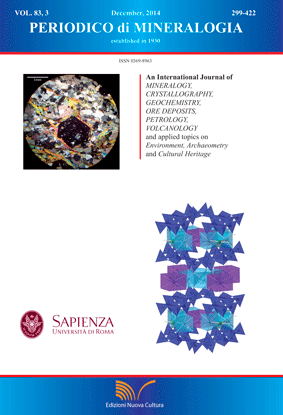High density silica phases as evidence of small-scale hypervelocity impacts: the Gebel Kamil Crater (Egypt)
DOI:
https://doi.org/10.2451/2014PM0016Keywords:
high T-P silica phases, coesite, stishovite, Gebel Kamil CraterAbstract
The Kamil Crater is a recent well-preserved impact crater in south-eastern Egypt formed by the explosive hypervelocity impact of a metallic impactor on hypersilic sedimentary rocks. The present study deals with the distribution of high P-T silica phases in different materials present in the crater and in surrounding formations (target rocks, fallback deposits, ejected impact products, and aeolian sands). X-ray diffraction analysis reveals that coesite is ubiquitously present in all materials analyzed, including aeolian sediments collected at considerable distance (>700 m) from the crater. Impactite clasts exhibit quite variable high P-T silica phase associations. Stishovite occurs exclusively in coesite-bearing impactites accompanied in one sample by mullite. High-T low-P silica polymorphs (cristobalite) were found in some strongly vitreous impactites proximal to the crater. A solid-state quartz-coesite transition occurring under shear stress conditions is considered for most of the coesite present in target rocks and dispersed in surrounding sediments. In largely melted impactite clasts, stishovite may crystallize from high-pressure silica liquid under conditions of shock compression while coesite will be formed behind the shock front.
Data suggest that in the case of small-scale hypervelocity impacts occurring in siliceous terrains, high P-T silica phases together micro-deformations in shocked quartz may represent the most suitable diagnostic parameters, especially for old impacts when primary features could be completely hidden by alteration processes.


